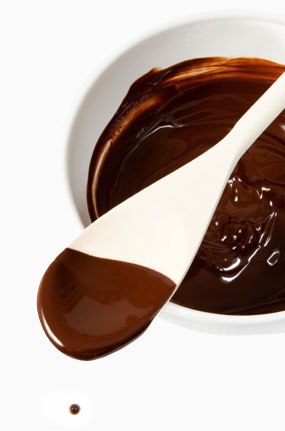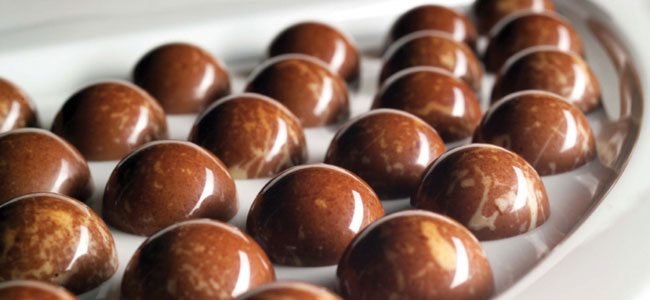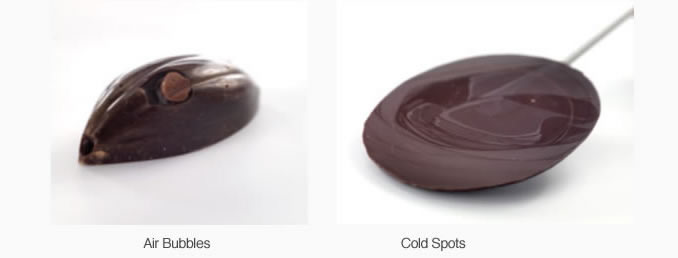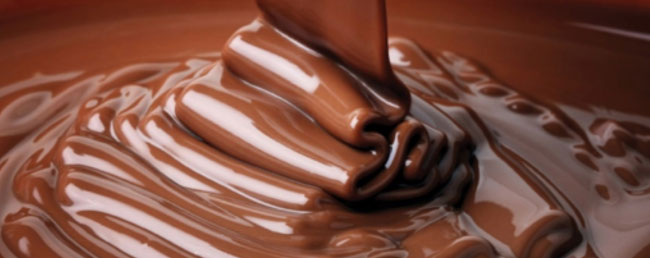Tempering Explained
Posted: 01 Nov 2013
What is tempering?

Tempering is the process of heating and cooling chocolate in order to establish the correct crystalline form once it has been melted. The purpose of tempering is to pre-crystallise the cocoa butter in the chocolate, during this process the cocoa butter in the chocolate changes into a stable crystalline form, ensuring you achieve the desired finished results.
Why should I temper my chocolate?
Tempering your chocolate couverture is vital to ensure you obtain chocolate with an even gloss and crunch and good shrinking force: ensuring that the process of de-moulding your chocolate is as easy as possible. Tempering involves the pre-crystallisation of cocoa butter crystals to a stable format and ensures that you achieve glossy chocolate with an optimum shelf life, smooth mouthfeel and a good ‘snap.’ When using chocolate to mould figures, dip truffles or decorate cakes – or whenever you require a glossy, hard finish – you will need to temper the chocolate first. If you are using chocolate as an added ingredient in a recipe, such as when making a chocolate mousse or cake, it is usually sufficient to just melt your chocolate and add at the required stage – you do not need to temper for these applications!

What happens if I don’t temper my chocolate?
If you have insufficient crystals or too many crystals in your finished product, you will experience problems when unmoulding and potentially defects in your chocolates too. Defects can include air bubbles which create gaps in your finished chocolates, chocolates which are difficult to unmould and a dull, uneven surface.

Methods of Tempering
There are various methods of tempering available both to the first-timer and the more experienced chocolatier alike; the most traditional method of tempering is to cool and thicken the chocolate by moving continuously on a marble worktop, although this method is rarely practiced in commercial environments today.
You can also temper your chocolate by seed tempering with easymelt chips – these are the round, flat drops of chocolate couverture commonly used by chocolatiers. This involves melting the chocolate to 40°C-45°C to remove all crystals, then adding pre-tempered chips to begin the crystallisation process and bring the chocolate down to the required working temperature of either dark, milk or white chocolate. The easiest and most beginner-friendly technique is to temper your chocolate in the microwave, using the method below.
Whichever method of tempering you choose, always remember the three most important elements of this process: time, temperature and movement.

Microwave Tempering
- Pour your easymelt chips into a microwaveable bowl and melt on ‘high’ in 30 second bursts until the chips are starting to soften. As a guideline to begin the melting process, heat your chocolate in the microwave for 1 minute for every kilo of chips. Stir really well with a spatula each time you remove the bowl from the microwave, ensuring that the heat is distributed evenly and the chips do not scorch. Even if the chips look solid at this point, start stirring and you will notice that they have softened more than you might think!
- When the chips have started to melt place the bowl back in the microwave for 5-10 second bursts until the chocolate is nearly all melted, stirring well each time. As the chocolate continues to melt, use further 2-3 second bursts of heat but only if you need to increase the fluidity of your chocolate.
- Once you have a smooth, slightly thickened liquid, your chocolate is tempered and ready to work with!
- IMPORTANT NOTE: Your objective is to gradually warm the chocolate to the required working temperature; 32°C for dark chocolate; 31°C for milk chocolate and 30°C for white chocolate. Make sure that your chocolate never exceeds 34°C even if it is still quite thick – different chocolates have different fluidity rates at the same temperature. Above this temperature, you run the risk of destroying all crystals present in your chocolate and your chocolate will no longer be tempered. Use a spatula and hand held thermometer or a spatula with thermometer attached to check the temperature of your chocolate.
TIP: To check whether your chocolate is tempered put the tip of a palette knife into the chocolate, if correctly tempered the chocolate will harden evenly with a good shine within about 3 minutes at a room temperature of approximately 20°C.
Seed Tempering with Chips
Seed tempering with chips is an entirely different process to tempering in the microwave, involving a different method of crystallisation to the microwave method. The ‘seed’ method involves adding pre-tempered chips to melted chocolate, thereby introducing stable crystals to your melted chocolate. To try out this method of tempering, simply follow the steps below.
- Melt the required quantity of easymelt chips in a melting pan or holding tank by setting the temperature to 45°C. Make sure you weigh your chocolate before melting to ensure you add the correct quantity of chips in step 2.
- Once the chocolate reaches a temperature of approximately 40°C, lower the set temperature to 32°C for dark chocolate, 31°C for milk chocolate and 30°C for white chocolate. At this stage add chips at an ambient temperature to 15% to 20% of the total weight of melted chocolate.
- Stir well to start melting the chips and to ensure even distribution of the stable crystals within the melted chocolate. If the chips are melting too quickly, this is because the chocolate is still too hot – continue stirring while adding more chips.
- Stop adding chips when the required working temperature is reached – you should now have a slightly thickened liquid which is tempered and ready to work with.

What next?
If you wish to progress beyond the microwave method of tempering, KeyChoc – Keylink’s sister company – supply a variety of small machines to assist you with all aspects of chocolate making. KeyChoc supply a range of table-top machines, including holding tanks, moulding machines and vibrating tables - visit KeyChoc’s website here. If you are just starting up or only need a machine for a short time, KeyChoc also offer a hire service on their machinery. See our article on KeyChoc machinery covering Manual Tempering, Automatic Batch Tempering and Continuous Tempering machines for the next stage in chocolate production.
.svg)